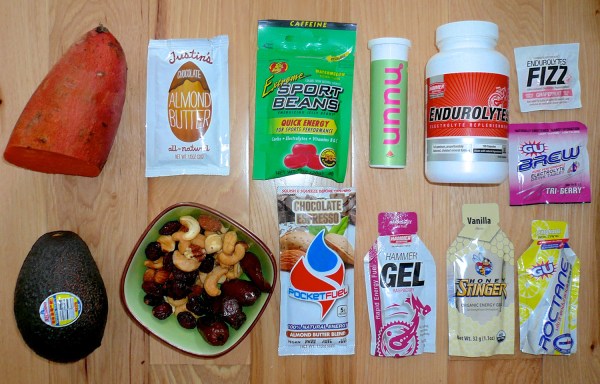As the adage goes, “Never try something new on race day.”
This goes for everything from gear to technique to, above all, nutrition. Just because an accomplished runner tells you the night before your race that eating a pound of raw spinach helps him perform at his peak does not mean you should house a bag of spinach right then and there. (I speak from experience here.)
So, what’s a runner to do? Here are a few tips to help you develop a fueling strategy for your long runs.
A Brief Guide to Exercise Nutrition
To fuel itself in endurance sports, your body can draw its energy from one of two places: (1) glycogen—carbohydrates that your body stores in the muscles and liver for easily accessible, high-octane energy, or (2) its fat stores—a slower-burning source of energy that is virtually endless, even in extremely lean athletes.
When you run long distances, the primary fuel your body relies on—at least initially—is glycogen. Hence the common practice of “carbo loading” the night before a marathon. Consuming lots of carbohydrates like pasta, bread or potatoes helps max out your glycogen stores to ensure you start a race with a full tank.
Without replenishment while running, glycogen stores are typically exhausted within a couple hours. If you want to run longer than that, you’ll want to consume some kind of mid-run fuel to replenish your glycogen stores, stave off fatigue and help activate fat burning for fuel.

Types of Fuel
If you plan to run three to four hours, you can often get away with only consuming simple, easily digested carbohydrates and sugars—for example, energy gels, chews, electrolyte drinks, fruit or starchy vegetables.
If you’re running longer, consider including some fat and protein as well—for example, energy bars, nuts or nut butters in individual packets, beef jerky or bars, avocadoes or a drink mix that incorporates fat and protein. These slower-burning forms of fuel will help you maintain steadier levels of energy on multi-hour runs.
If it’s hot enough out that you’re sweating profusely, be sure to also replenish your sodium and electrolytes. Good bets are potato chips, electrolyte drinks or salt tablets (no more than 1–2 per hour).
How Much Should I Eat?
This will vary by individual, based on a variety of factors like body mass, composition and personal preference. Nevertheless, a good range to aim for is to consume 200–250 calories per hour of running.
Don’t wait to feel hungry. Even if you don’t feel like eating, do it anyway; your body needs it. Some runners set a watch to go off at 20- or 30-minute intervals to remind them to consume 80–100 calories each time their watch beeps.
Trial and Error
Experimenting and discovering what makes your individual body’s motor hum is one of the joys of being a runner. Try everything—multiple times—in training first.
Some runners’ stomachs are made of steel and can handle almost any kind of food input. If you fall into this category, congratulations!
If, however, your stomach is easily irritated or prone to nausea, particularly when jostled as running tends to do, get acquainted with the nutritional labels on products. Consider avoiding products with common allergens or irritants like gluten, whey or soy, and see if that makes a difference. Dairy- and gluten-free bars are options.
Also, if you have a sensitive stomach, try avoiding solid foods. Experiment instead with products like sports drinks, pureed plant-based foods, nutritional shakes or homemade smoothies.
Make Your Own
As any thru-hiker can tell you, the key to endurance fuel is caloric density. You want the most bang for your buck, particularly if you’re carrying your own mid-run fuel in a hydration pack. Here are a few great, portable homemade fuel options, which can be foil wrapped or stored in a plastic zip bag:
- Boiled, salted chunks of sweet potato
- Tortilla filled with chocolate hazelnut spread and banana; turkey and hummus; or black beans and guacamole
- Peanut-butter-and-jelly sandwich
- White rice and miso in a seaweed wrap
- Mixes of nuts and dried fruit like dates, figs, cranberries or mango
- Rice cakes or homemade energy bars from a book like Feed Zone Portables: A Cookbook of On-the-Go Food for Athletes or Power Hungry: The Ultimate Energy Bar Cookbook
Happy running eating!
